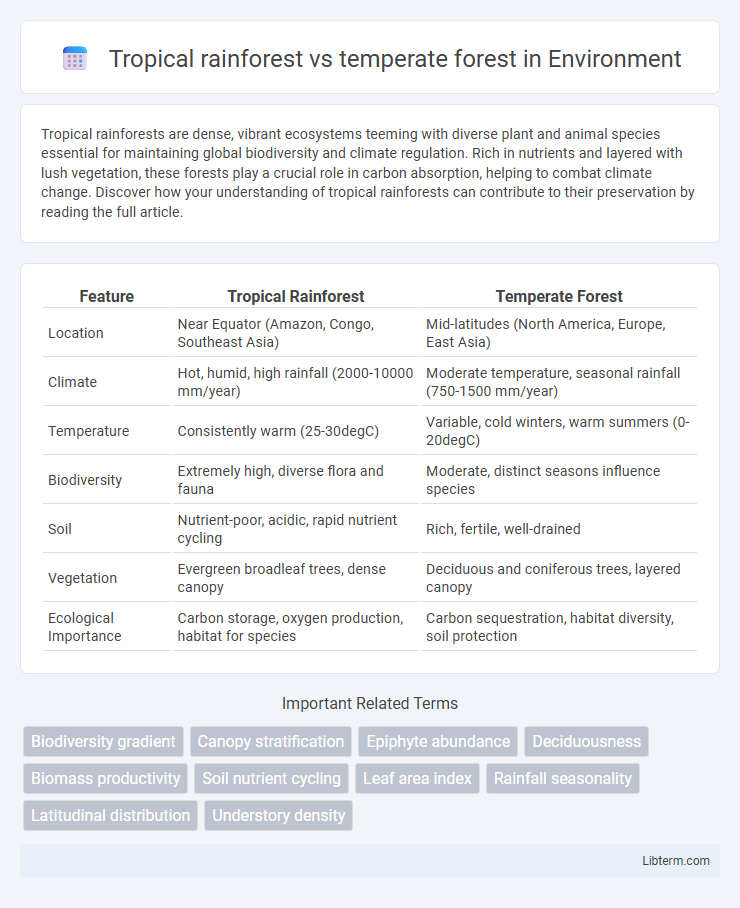Tropical rainforests are dense, vibrant ecosystems teeming with diverse plant and animal species essential for maintaining global biodiversity and climate regulation. Rich in nutrients and layered with lush vegetation, these forests play a crucial role in carbon absorption, helping to combat climate change. Discover how your understanding of tropical rainforests can contribute to their preservation by reading the full article.
Table of Comparison
| Feature | Tropical Rainforest | Temperate Forest |
|---|---|---|
| Location | Near Equator (Amazon, Congo, Southeast Asia) | Mid-latitudes (North America, Europe, East Asia) |
| Climate | Hot, humid, high rainfall (2000-10000 mm/year) | Moderate temperature, seasonal rainfall (750-1500 mm/year) |
| Temperature | Consistently warm (25-30degC) | Variable, cold winters, warm summers (0-20degC) |
| Biodiversity | Extremely high, diverse flora and fauna | Moderate, distinct seasons influence species |
| Soil | Nutrient-poor, acidic, rapid nutrient cycling | Rich, fertile, well-drained |
| Vegetation | Evergreen broadleaf trees, dense canopy | Deciduous and coniferous trees, layered canopy |
| Ecological Importance | Carbon storage, oxygen production, habitat for species | Carbon sequestration, habitat diversity, soil protection |
Introduction to Tropical and Temperate Forests
Tropical rainforests are characterized by high biodiversity, consistent warm temperatures, and heavy rainfall exceeding 2000 mm annually, supporting dense, multi-layered vegetation. Temperate forests experience moderate climate with distinct seasons, including cold winters and warm summers, and receive annual precipitation ranging from 750 to 1500 mm, fostering deciduous and evergreen tree species. Both forest types play crucial roles in carbon sequestration and habitat provision but differ significantly in climate, species composition, and ecological dynamics.
Geographic Distribution and Climate
Tropical rainforests are primarily located near the equator, spanning regions such as the Amazon Basin in South America, the Congo Basin in Africa, and Southeast Asia, where they experience consistently high temperatures averaging 20-25degC and annual rainfall exceeding 2000 mm. In contrast, temperate forests are found in the mid-latitudes of North America, Europe, and parts of Asia, characterized by moderate temperatures that range from -30degC to 30degC and four distinct seasons with annual precipitation between 750-1500 mm. The climate in tropical rainforests promotes high biodiversity due to constant warmth and moisture, while temperate forests undergo seasonal changes that influence flora and fauna adaptations.
Biodiversity and Species Richness
Tropical rainforests exhibit unparalleled biodiversity and species richness, housing over half of the world's terrestrial species despite covering only about 6% of the Earth's surface. These ecosystems support diverse flora and fauna due to stable warm temperatures and high annual rainfall, fostering complex habitats and intricate ecological interactions. In contrast, temperate forests feature moderate biodiversity with fewer endemic species, as seasonal climate fluctuations limit species adaptation and diversity compared to tropical environments.
Vegetation Structure and Canopy Layers
Tropical rainforests feature dense, multi-layered canopies with emergent trees soaring above a closed upper canopy, supporting a rich diversity of epiphytes and lianas. Temperate forests have simpler canopy structures with fewer layers, typically consisting of a dominant canopy, understory, and forest floor, where tree species exhibit seasonal leaf shedding. The complexity and biodiversity of vegetation in tropical rainforests are significantly higher due to stable warm temperatures and high rainfall throughout the year.
Soil Composition and Nutrient Cycling
Tropical rainforests have highly weathered, acidic soils with low nutrient content due to heavy rainfall leaching minerals, but rapid decomposition and nutrient cycling in the dense vegetation maintain soil fertility. Temperate forests possess richer, more fertile soils with higher organic matter accumulation owing to slower decomposition rates and moderate rainfall, supporting diverse plant growth. Nutrient cycling in temperate forests is slower compared to tropical rainforests, resulting in a more stable but less dynamic soil nutrient profile.
Flora and Fauna Differences
Tropical rainforests exhibit dense, multi-layered vegetation with towering evergreen trees such as mahogany and kapok, supporting diverse flora like orchids and ferns, while temperate forests feature deciduous trees like oak, maple, and beech, with undergrowth including shrubs and mosses. Fauna in tropical rainforests includes species with high biodiversity like jaguars, toucans, and numerous insect varieties, whereas temperate forests are home to animals like deer, black bears, and a variety of migratory birds adapted to seasonal changes. The constant warm climate of tropical rainforests fosters year-round growth and complex ecosystems, while temperate forests experience seasonal cycles influencing species behavior and vegetation patterns.
Ecological Roles and Functions
Tropical rainforests support unparalleled biodiversity, acting as critical carbon sinks and regulating global climate by storing vast amounts of carbon in dense vegetation and soil. Temperate forests contribute to nutrient cycling and provide habitat for diverse species adapted to seasonal changes, while also playing a significant role in water filtration and soil stabilization. Both ecosystems maintain ecological balance, but tropical rainforests have higher primary productivity and species richness compared to temperate forests.
Human Impact and Deforestation
Tropical rainforests face severe deforestation primarily due to logging, agriculture, and palm oil plantations, leading to loss of biodiversity and disruption of carbon storage. Temperate forests experience human impact through urbanization, unsustainable logging, and forest fires caused by land clearing, affecting local ecosystems and carbon sequestration. Both forest types suffer from habitat fragmentation and reduced ecosystem services, but tropical rainforests are more vulnerable due to their higher biodiversity and critical role in global climate regulation.
Conservation Strategies and Challenges
Tropical rainforest conservation strategies prioritize protecting biodiversity hotspots through establishing protected areas, promoting sustainable land-use practices, and engaging indigenous communities in forest management. Temperate forest conservation focuses on habitat restoration, controlling invasive species, and implementing fire management techniques to maintain ecosystem resilience. Both forest types face challenges from deforestation, climate change, and human encroachment, requiring adaptive policies and international collaboration for effective conservation.
Future Outlook and Sustainability
Tropical rainforests, vital carbon sinks, face severe threats from deforestation, but reforestation initiatives and sustainable agroforestry practices offer paths to recovery and climate resilience. Temperate forests benefit from advanced forest management and conservation policies enhancing biodiversity while supporting renewable timber industries. Integrating indigenous knowledge with modern science is crucial for sustaining both ecosystems amid climate change and human pressures.
Tropical rainforest Infographic

 libterm.com
libterm.com